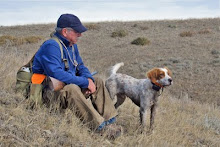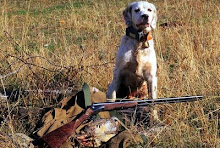
I enjoy bagging (or buying), preparing and eating meat. I offer no apologizes for this. I enjoy preparing meals and have a decent library of culinary books. Recently I was looking for a classic partridge recipe, including guidelines for hanging birds prior to cooking
. A book I bought about two years ago - The River Cottage Meat Book, by Hugh Fearnley-Whittingstall (published by
Ten Speed Press) has a lot of informed and practical information on cooking all types of meat, and has an excellent treatment of all types of game - game common to the British Isles, anyway. The photography by Simon Wheeler is excellent and mouth-watering.
Fearnley-Whittingstall is a hunter and dog owner (this is the connection that justifies its inclusion on this blog...), a chef, and owner of River Cottage farm. In his introductory pages he bows to the typical British sensitivity regarding animal welfare and expresses regret that some game animals are not dispatched cleanly. A concern that most hunters also share.
"... As I pull the trigger and the bird falls, or the beast tumbles, I feel the gap between me and the quarry, which a moment ago seemed unreachable, closed in an instant."
And he does not shy away from straight talk about other possibly sensitive culinary subjects. Here is what he has to say about fat in food...
"Fat gets bad press. Because few of us want to ge 'fat', and because the consumption of 'fat' (the noun) has been identified as one possible cause of people becoming 'fat' (the adjective), fat the substance has been effectively demonized. Yet fat has a critical role in brokering the flavor of meat-not just meat, in fact, but in many of our favorite foods. That's why we put butter on our bread, beef fat in our Christmas pudding, and crated cheese on our pasta.
The critical thing is that many flavor-bearing molecules are soluble in fat but not in water. In addition, the flavorful substances into otherwise dry foods are far more effectively absorbed by the taste buds when combined with or accompanied by fat..."
On hanging game...
"The other thing to say about gaminess, besides, perhaps, that not everyone likes it, is that its level, or intensity, is not a given. It can be encouraged or discouraged, according to the length of time for which the creature has hung." And there follows an in-depth discussion of hanging (or aging) all types of game.
Bottom line, I find tis book even more useful (and inspiring!) than either The Complete Meat Cookbook by Bruce Aidells and Denis Kelly or Roasting by Barbara Kaufka, both good books in their own right.
 Several years ago I was homeward bound from a client meeting in Paris, and was seated next to a pleasant young woman from Sweden - an agricultural journalist, she said. Somehow (perhaps inevitably) the conversation turned to bird dogs and setters. She was a bird hunter and bird dogger and she talked to me a bit about the influence of the Smith setters in Norway and Sweden. She sent the the photo above by e-mail a few days later. I have always liked the photo and offer it here.
Several years ago I was homeward bound from a client meeting in Paris, and was seated next to a pleasant young woman from Sweden - an agricultural journalist, she said. Somehow (perhaps inevitably) the conversation turned to bird dogs and setters. She was a bird hunter and bird dogger and she talked to me a bit about the influence of the Smith setters in Norway and Sweden. She sent the the photo above by e-mail a few days later. I have always liked the photo and offer it here.









